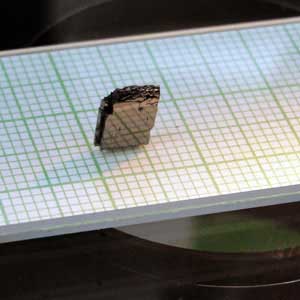Scientists at the U.S. Dept. of Energy (DOE)’s Ames Laboratory have observed the magnetic properties typically associated with those observed in rare-earth elements in iron. These properties are observed in a new iron based compound that does not contain rare earth elements, when the iron atom is positioned between two nitrogen atoms.
he discovery opens the possibility of using iron to provide both the magnetism and permanence in high-strength permanent magnets, like those used in direct-drive wind turbines or electric motors in hybrid cars. The results appeared in Nature Communications.
Canfield’s research group is internationally known for expertise in design, discovery, growth and characterization of new and promising materials. In this effort, Canfield and his colleagues, including postdoctoral research associate Anton Jesche, designed a new technique to grow lithium-iron-nitride single crystals from a lithium-nitrogen solution.
“Using nitrogen in solution growth had not yet been well explored because, since we typically think of nitrogen as a gas, it’s challenging to get into a solution” said Jesche, “But we found that lithium—lightest solid element—looked like it could hold nitrogen in solution. So, we mixed together lithium and lithium-nitride powder, and it worked. It created a solution.”
Then the group added in iron and, to their surprise, the iron dissolved.
“Usually iron and lithium don’t mix,” said Canfield, who is also a professor of physics and astronomy at the Iowa State University. He also added “It seems adding nitrogen to the lithium in the solution allows iron to go in.”
The resulting single crystals of iron-substituted lithium nitride yielded even more surprises: the opposing external field required to reverse magnetization was more than 11 T, as much as an order of magnitude larger than that of commercially available permanent magnets and two or more orders of magnitude larger than is typically found in a single crystals. Further evidence of iron’s exotic state in this compound is the field-induced quantum tunneling found for very diluted iron concentrations at the relatively high temperature of 10 K, a temperature orders of magnitude higher than what had been seen before.
With detailed measurements, we saw that these single iron ions are indeed behaving like a single rare-earth ion would, Canfield said and continued-“We believe this has to do with the special, fairly simple, geometry that the iron finds itself in: one iron atom positioned between two nitrogen atoms. We hope this crystal growing technique and this specific material can be a model system for further theoretical study of these rare-earth-like iron ions. As it stands, these materials have clear implications on finding rare-earth-free replacements for permanent magnets—and perhaps also may impact data storage and manipulation in quantum computer applications.”






